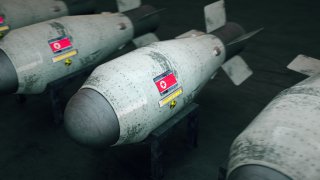A Forlorn Hope for Korean Denuclearization
A narrow path to a nuke-free Korean peninsula is worth pursuing, even if that comes at a high fiscal cost.
Concerning North Korea's nuclear weapons program, the interesting question is, what would be the circumstances in which Pyongyang would consider surrendering its nuclear deterrent? The context is clear. Kim Jong-un faces two potential threats to the survival of his regime—internal and external. Kim sees the need to defend against both, and any way forward must help him achieve both goals. To neutralize the first, Kim needs to look after the people that matter. These are the roughly 3 million people living in the capital. Over his decade in power, he has privileged Pyongyang to an excessive degree, stretching wide the economic gap between town and country. A massive building program has delivered tens of thousands of new apartments and leisure facilities to the inhabitants. The funfairs, restaurants, leisure, and sports facilities in the capital are twinned with the Masik ski resort, the beaches of Wonsan, and Mount Kumgang’s package tours to deliver outside what is practically unavailable at home. At the same time, the markets are well stocked for those with the money to pay. The very success of this gambit is demonstrated by the recent decision to strengthen controls around the capital to mitigate the economic pull of internal migration for those locked outside.
The external threat from Seoul, let alone Washington and Tokyo, is so enormous that the North is totally out-gunned. There is no alternative since conventional deterrence is no longer credible or feasible. Seoul’s 10 percent plus increase in military spending in 2021 was greater than the North’s annual military budget, leaving Pyongyang with no option apart from nuclear deterrence. Serendipitously, it has the collateral benefit of addressing the North’s key economic bottlenecks, choking any prospect of serious growth—manpower and energy. With more than a million men in the Korean Peoples Army, this deterrence strategy provides the opportunity and prospect of demobilizing hundreds of thousands into factories and workshops, as foreseen in Kim's 2019 New Year’s Address. In parallel, the civil face of the nuclear program with indigenous Light Water Reactors would help fill the energy gap.
Thus, with patience and remittance, there is a narrow path to denuclearization. It will take at least a decade and more. Pyongyang will require serious and solid security guarantees—not a letter from a sitting U.S. president, but rather something similar to the Iran Deal, where the UN Security Council signed off on the Joint Comprehensive Plan of Action. Along with that, Pyongyang will need major funding with a decade-long budget of $25-30 billion to rehabilitate its economy and infrastructure. There would be step-by-step progress, first with a nuclear and ICBM testing freeze in exchange for easing sanctions. Then, the hard part, with both sides committing to irreversible concessions with an “end of war” declaration and unrestricted and unqualified sanctions relief traded for the North, giving up its plutonium and highly enriched uranium programs as the next step forward. This long quest continues until the North gives up its nuclear weapons. Even if, at some point, the deal falls apart, the world will be in a better place than without an agreement. Many will argue that $30 billion is too high a price to reward bad behavior. Yet with the North's recent rapprochement with Moscow, it’s a bargain compared to the global cost of nuclear conflagration on the Korean peninsula.
Glyn Ford is a former Member of the European Parliament specializing in Trade and Foreign Affairs who now works with the NGO Track2Asia. He has visited North Korea close to fifty times and is the author of Talking to North Korea (2018, Pluto Press) and Picturing the DPRK (Pacific Century Institute, 2023). Both are available in Korean.
Image: Shutterstock.

